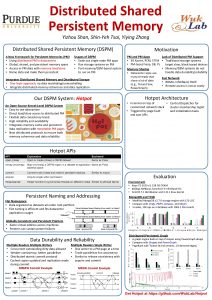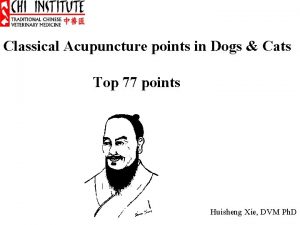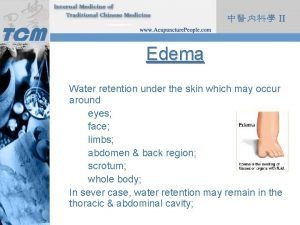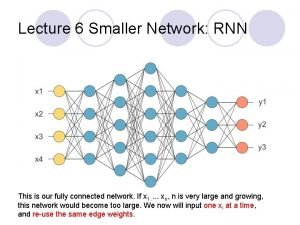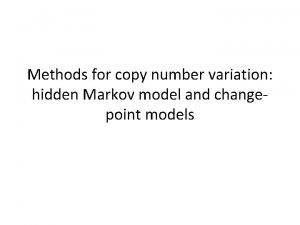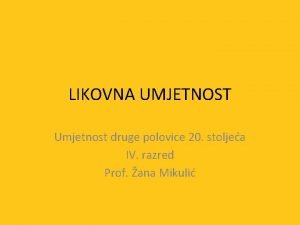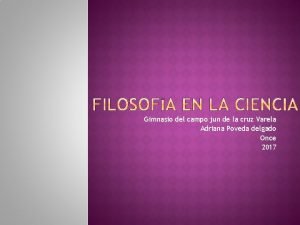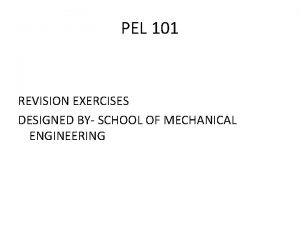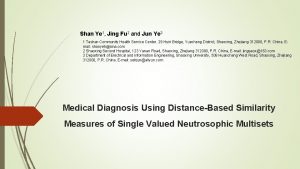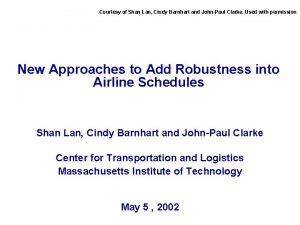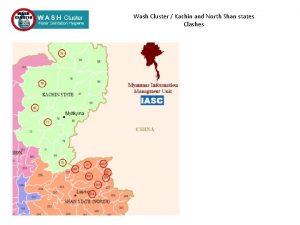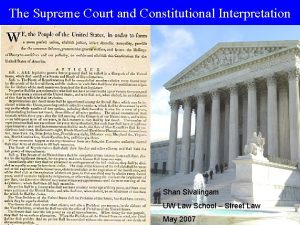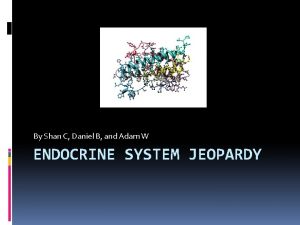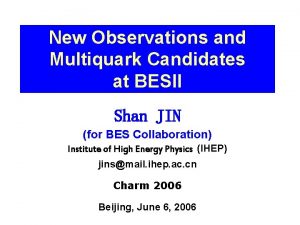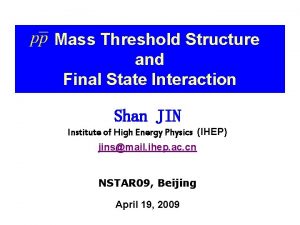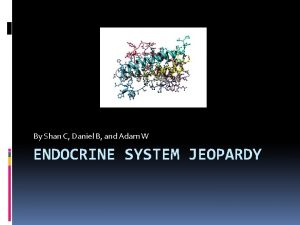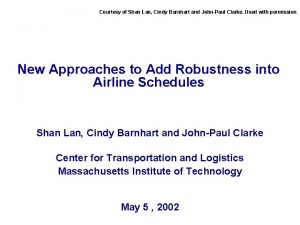Shan Ye 1 Jing Fu 2 and Jun




![1. Introduction – cont. After that, Wang et al [4] introduced a single valued 1. Introduction – cont. After that, Wang et al [4] introduced a single valued](https://slidetodoc.com/presentation_image_h2/8ff8ea819111be987e00e0d30b316f27/image-5.jpg)

![1. Introduction – cont. Recently, Ye [5 -7] proposed some similarity measures of SVNSs 1. Introduction – cont. Recently, Ye [5 -7] proposed some similarity measures of SVNSs](https://slidetodoc.com/presentation_image_h2/8ff8ea819111be987e00e0d30b316f27/image-7.jpg)

![1. Introduction – cont. Recently, Ye et al. [11] presented a single valued neutrosophic 1. Introduction – cont. Recently, Ye et al. [11] presented a single valued neutrosophic](https://slidetodoc.com/presentation_image_h2/8ff8ea819111be987e00e0d30b316f27/image-9.jpg)
![2. Preliminaries. 2. 1 Some concepts of SVNSs Smarandache [3] originally presented the concept 2. Preliminaries. 2. 1 Some concepts of SVNSs Smarandache [3] originally presented the concept](https://slidetodoc.com/presentation_image_h2/8ff8ea819111be987e00e0d30b316f27/image-10.jpg)
![2. Preliminaries – cont. 2. 1 Some concepts of SVNSs However, Smarandache [3] introduced 2. Preliminaries – cont. 2. 1 Some concepts of SVNSs However, Smarandache [3] introduced](https://slidetodoc.com/presentation_image_h2/8ff8ea819111be987e00e0d30b316f27/image-11.jpg)




























![References – cont. [6] J. Ye. Multiple attribute group decision-making method with completely unknown References – cont. [6] J. Ye. Multiple attribute group decision-making method with completely unknown](https://slidetodoc.com/presentation_image_h2/8ff8ea819111be987e00e0d30b316f27/image-40.jpg)
- Slides: 40

Shan Ye 1, Jing Fu 2 and Jun Ye 3 1 Tashan Community Health Service Center. 29 Huiri Bridge, Yuecheng District, Shaoxing, Zhejiang 312000, P. R. China. E-mail: shanyeh@sina. com 2 Shaoxing Second Hospital, 123 Yanan Road, Shaoxing, Zhejiang 312000, P. R. China, E-mail: jingsaox@163. com 3 Department of Electrical and Information Engineering, Shaoxing University, 508 Huancheng West Road, Shaoxing, Zhejiang 312000, P. R. China. E-mail: yehjun@aliyun. com Medical Diagnosis Using Distance-Based Similarity Measures of Single Valued Neutrosophic Multisets

Abstract. This presentation proposes a generalized distance measure and its similarity measures between single valued neutrosophic multisets (SVNMs). Then, the similarity measures are applied to a medical diagnosis problem with incomplete, indeterminate and inconsistent information. This diagnosis method can deal with the diagnosis problem with indeterminate and inconsistent information which cannot be handled by the diagnosis method based on intuitionistic fuzzy multisets (IFMs).

1. Introduction. The vagueness or uncertainty representation of imperfect knowledge becomes a crucial issue in the areas of computer science and artificial intelligence. To deal with the uncertainty, the fuzzy set proposed by Zadeh [1] allows the uncertainty of a set with a membership degree between 0 and 1. [1] L. A. Zadeh. Fuzzy Sets. Information and Control, 8 (1965), 338 -353. Then, Atanassov [2] introduced an intuitionistic Fuzzy set (IFS) as a generalization of the Fuzzy set. [2] K. Atanassov. Intuitionistic fuzzy sets. Fuzzy Sets and Systems, 20 (1986), 87 -96.

1. Introduction – cont. The IFS represents the uncertainty with respect to both membership and non-membership. However, it can only handle incomplete information but not the indeterminate and inconsistent information which exists commonly in real situations. Therefore, Smarandache [3] proposed a neutrosophic set. It can independently express truth-membership degree, indeterminacy-membership degree, and false-membership degree and deal with incomplete, indeterminate, and inconsistent information. [3] F. Smarandache. A unifying field in logics. neutrosophy: Neutrosophic probability, set and logic. Rehoboth: American Research Press, 1999.
![1 Introduction cont After that Wang et al 4 introduced a single valued 1. Introduction – cont. After that, Wang et al [4] introduced a single valued](https://slidetodoc.com/presentation_image_h2/8ff8ea819111be987e00e0d30b316f27/image-5.jpg)
1. Introduction – cont. After that, Wang et al [4] introduced a single valued neutrosophic set (SVNS), which is a subclass of the neutrosophic set. S VNS is a generalization of the concepts of the classic set, fuzzy set, and IFS. The SVNS should be used for better representation as it is a more natural and justified estimation [4] H. Wang, F. Y. Smarandache, Q. Zhang, and R. Sunderraman. Single valued neutrosophic sets. Multispace and Multistructure, 4 (2010), 410 -413.

1. Introduction – cont. All the factors described by the SVNS are very suitable for human thinking due to the imperfection of knowledge that human receives or observes from the external world. For example, for a given proposition “Movie X would be hit”, in this situation human brain certainly cannot generate precise answers in terms of yes or no, as indeterminacy is the sector of unawareness of a proposition’s value between truth and falsehood. Obviously, the neutrosophic components are best fit in the representation of indeterminacy and inconsistent information.
![1 Introduction cont Recently Ye 5 7 proposed some similarity measures of SVNSs 1. Introduction – cont. Recently, Ye [5 -7] proposed some similarity measures of SVNSs](https://slidetodoc.com/presentation_image_h2/8ff8ea819111be987e00e0d30b316f27/image-7.jpg)
1. Introduction – cont. Recently, Ye [5 -7] proposed some similarity measures of SVNSs and applied them to decision making and clustering analysis. [5] J. Ye and Q. S. Zhang. Single valued neutrosophic similarity measures for multiple attribute decision making. Neutrosophic Sets and Systems, 2 (2014), 48 -54. [6] J. Ye. Multiple attribute group decision-making method with completely unknown weights based on similarity measures under single valued neutrosophic environment. Journal of Intelligent and Fuzzy Systems, (2014). [7] J. Ye. Clustering methods using distance-based similarity measures of single-valued neutrosophic sets. Journal of Intelligent Systems, (2014). Based on multiset theory, Yager [8] introduced a fuzzy multiset concept, which allows the repeated occurrences of any element. [8] R. R. Yager. On theory of bags (Multi sets). International Journal of General System, 13 (1986), 23 -37.

1. Introduction – cont. Thus, the fuzzy multiset can occur more than once with the possibility of the same or different membership values. Then, Shinoj and Sunil [9] extended the fuzzy multiset to the intuitionistic fuzzy multiset (IFM) and presented some basic operations and a distance measure for IFMs, and then applied the distance measure to medical diagnosis. [9] T. K. Shinoj and J. J. Sunil. Intuitionistic fuzzy multi sets and its application in medical diagnosis. World Academy of Science, Engineering and Technology, 6(1) (2012), 14181421. Rajarajeswari and Uma [10] put forward the Hamming distance-based similarity measure for IFMs and its application in medical diagnosis. [10] P. Rajarajeswari and N. Uma. Normalized Hamming Similarity Measure for Intuitionistic Fuzzy Multi Sets and Its Application in Medical diagnosis. Intl. Journal of Mathematics Trends and Technology, 5(3) (2014), 219 -225.
![1 Introduction cont Recently Ye et al 11 presented a single valued neutrosophic 1. Introduction – cont. Recently, Ye et al. [11] presented a single valued neutrosophic](https://slidetodoc.com/presentation_image_h2/8ff8ea819111be987e00e0d30b316f27/image-9.jpg)
1. Introduction – cont. Recently, Ye et al. [11] presented a single valued neutrosophic multiset (SVNM) as a generalization of IFM and the Dice similarity measure between SVNMs, and then applied it to medical diagnosis. [11] S. Ye and J. Ye. Dice similarity measure between single valued neutrosophic multisets and its application in medical diagnosis. Neutrosophic Sets and Systems, 2014. Based on SVNMs, this paper further develops a generalized distance measure and the distance-based similarity measures between SVNMs, and then applies the similarity measures to medical diagnosis.
![2 Preliminaries 2 1 Some concepts of SVNSs Smarandache 3 originally presented the concept 2. Preliminaries. 2. 1 Some concepts of SVNSs Smarandache [3] originally presented the concept](https://slidetodoc.com/presentation_image_h2/8ff8ea819111be987e00e0d30b316f27/image-10.jpg)
2. Preliminaries. 2. 1 Some concepts of SVNSs Smarandache [3] originally presented the concept of a neutrosophic set. [3] F. Smarandache. A unifying field in logics. neutrosophy: Neutrosophic probability, set and logic. Rehoboth: American Research Press, 1999. A neutrosophic set A in a universal set X is characterized by a truth-membership function TA(x), an indeterminacymembership function IA(x), and a falsity-membership function FA(x). The functions TA(x), IA(x), FA(x) in X are real standard or nonstandard subsets of ]− 0, 1+[, i. e. , TA(x): X → ]− 0, 1+[, IA(x): X → ]− 0, 1+[, and FA(x): X → ]− 0, 1+[. Then, the sum of TA(x), IA(x) and FA(x) is no restriction, i. e. − 0 ≤ sup T (x) + sup I (x) + sup F (x) ≤ 3+. A A A
![2 Preliminaries cont 2 1 Some concepts of SVNSs However Smarandache 3 introduced 2. Preliminaries – cont. 2. 1 Some concepts of SVNSs However, Smarandache [3] introduced](https://slidetodoc.com/presentation_image_h2/8ff8ea819111be987e00e0d30b316f27/image-11.jpg)
2. Preliminaries – cont. 2. 1 Some concepts of SVNSs However, Smarandache [3] introduced the neutrosophic set from philosophical point of view. [3] F. Smarandache. A unifying field in logics. neutrosophy: Neutrosophic probability, set and logic. Rehoboth: American Research Press, 1999. Therefore, it is difficult to apply the neutrosophic set to practical problems. To easily apply in science and engineering areas, Wang et al. [4] introduced the concept of SVNs, which is a subclass of the neutrosophic set and gave the following definition. [4] H. Wang, F. Y. Smarandache, Q. Zhang, and R. Sunderraman. Single valued neutrosophic sets. Multispace and Multistructure, 4 (2010), 410 -413.

2. Preliminaries – cont. 2. 1 Some concepts of SVNSs

2. Preliminaries – cont. 2. 1 Some concepts of SVNSs

2. Preliminaries – cont. 2. 1 Some concepts of SVNSs

2. Preliminaries. 2. 2 Some concepts of SVNMs As a generalization of the concept of IFM, a concept of SVNM and some basic operational relations for SVNMs [11] are introduced below. [11] S. Ye and J. Ye. Dice similarity measure between single valued neutrosophic multisets and its application in medical diagnosis. Neutrosophic Sets and Systems, 2014.

2. Preliminaries – cont. 2. 2 Some concepts of SVNMs

2. Preliminaries – cont. 2. 2 Some concepts of SVNMs

2. Preliminaries – cont. 2. 2 Some concepts of SVNMs

2. Preliminaries – cont. 2. 2 Some concepts of SVNMs

2. Preliminaries – cont. 2. 2 Some concepts of SVNMs

2. Preliminaries – cont. 2. 2 Some concepts of SVNMs

3. Distance and similarity measures of SVNMs. The distance measure and similarity measure are usually used in real science and engineering applications. Therefore, the section proposes a generalized distance measure between SVNMs and the distance-based similarity measures between SVNMs. However, the distance and similarity measures in SVNSs are considered for truth-membership, indeterminacymembership, and falsity-membership functions only once, while the distance and similarity measures in SVNMs should be considered more than once because their functions are multi-values.

3. Distance and similarity measures of SVNMs – cont.

3. Distance and similarity measures of SVNMs – cont.

3. Distance and similarity measures of SVNMs – cont.

3. Distance and similarity measures of SVNMs – cont.

3. Distance and similarity measures of SVNMs – cont. Based on the relationship between the distance measure and the similarity measure, we can introduce two distancebased similarity measures between A and B:

3. Distance and similarity measures of SVNMs – cont. Following Proposition 1 for the defined distance measure and the relationship between the distance measure and the similarity measure, it is easy to obtain Proposition 2 for the distance-based similarity measures.

3. Distance and similarity measures of SVNMs – cont. By the similar proofs of Proposition 1 and the relationship between the distance and the similarity measure, Proofs are straightforward.

3. Distance and similarity measures of SVNMs – cont. The calculation process of the similarity measures between A and B is shown as follows:

3. Distance and similarity measures of SVNMs – cont. Then, by applying Eqs. (2) and (3) we have the following result:

4. Medical diagnosis using the similarity measure. Due to more and more complexity of real medical diagnosis, a lot of information available to physicians from modern medical technologies is often incomplete, indeterminate and inconsistent information. Then, the SVNS proposed by Wang et al. [4] can be better to express this kind of information, but fuzzy sets and intuitionistic fuzzy sets cannot handle indeterminate and inconsistent information. [4] H. Wang, F. Y. Smarandache, Q. Zhang, and R. Sunderraman. Single valued neutrosophic sets. Multispace and Multistructure, 4 (2010), 410 -413. However, by only taking one time inspection, we wonder whether we can obtain a conclusion from a particular person with a particular decease or not.

4. Medical diagnosis using the similarity measure – cont. Sometimes he/she may also show the symptoms of different diseases. Then, how can we give a proper conclusion? One solution is to examine the patient at different time intervals (e. g. two or three times a day). Thus, authors present SVNMs as a better tool for reasoning such a situation. The details of a typical example (adapted from [9]) are given below. [9] T. K. Shinoj and J. J. Sunil. Intuitionistic fuzzy multi sets and its application in medical diagnosis. World Academy of Science, Engineering and Technology, 6(1) (2012), 14181421.

4. Medical diagnosis using the similarity measure – cont. Let P = {P 1, P 2, P 3, P 4} be a set of four patients, D = {D 1, D 2, D 3, D 4} = {Viral fever, Tuberculosis, Typhoid, Throat disease} be a set of diseases, and S = {S 1, S 2, S 3, S 4, S 5} = {Temperature, Cough, Throat pain, Headache, Body pain} be a set of symptoms. Table 1 shows the characteristics between symptoms and the considered diseases represented by the form of single valued neutrosophic values (SVNVs). In the medical diagnosis, if we have to take three different samples in three different times in a day (e. g. , morning, noon and night), we can construct Table 2, in which the characteristics between patients and the indicated symptoms are represented by SVNMVs.

4. Medical diagnosis using the similarity measure – cont.

4. Medical diagnosis using the similarity measure – cont. Then, by using Eqs. (1) and (2) and taking p = 2, we can obtain the similarity measure between each patient Pi (I = 1, 2, 3, 4) and the considered disease Dj (j = 1, 2, 3, 4), which are shown in Table 3. Similarly, by using Eqs. (1) and (3) and taking p = 2, we can obtain the similarity measure between each patient Pi (i = 1, 2, 3, 4) and the considered disease Dj (j = 1, 2, 3, 4), which are shown in Table 4. In Tables 3 and 4, the largest similarity measure indicates the proper diagnosis. Patient P 1 suffers from viral fever, Patient P 2 suffers from tuberculosis, Patient P 3 suffers from typhoid, and Patient P 4 also suffers from typhoid.

4. Medical diagnosis using the similarity measure – cont.

Conclusion. This paper proposed the generalized distance and its two similarity measures. Then, the two similarity measures of SVNMs were applied to medical diagnosis to demonstrate the effectiveness of the developed measure methods. The medical diagnosis shows that the new measures perform well in the case of truth-membership, indeterminacy-membership, and falsity-membership functions and the example depicts that the proposed measure is effective with the three representatives of SVNMV – truthmembership, indeterminacy-membership and falsitymembership values. Therefore, the measures of SVNMs make them possible to handle the diagnosis problems with indeterminate and inconsistent information, which cannot be handled by the measures of IFMs because IFMs cannot express and deal with the indeterminate and inconsistent information.

Conclusion – cont. References. In further work, it is necessary and meaningful to extend SVNMs to propose interval neutrosophic multisets and their operations and measures and to investigate their applications such as decision making, pattern recognition, and medical diagnosis. [1] L. A. Zadeh. Fuzzy Sets. Information and Control, 8 (1965), 338 -353. [2] K. Atanassov. Intuitionistic fuzzy sets. Fuzzy Sets and Systems, 20 (1986), 87 -96. [3] F. Smarandache. A unifying field in logics. neutrosophy: Neutrosophic probability, set and logic. Rehoboth: American Research Press, 1999. [4] H. Wang, F. Y. Smarandache, Q. Zhang, and R. Sunderraman. Single valued neutrosophic sets. Multispace and Multistructure, 4 (2010), 410413. [5] J. Ye and Q. S. Zhang. Single valued neutrosophic similarity measures for multiple attribute decision making. Neutrosophic Sets and Systems, 2 (2014), 48 -54. [6] J. Ye. Multiple attribute group decision-making method with completely unknown weights based on similarity measures under single valued neutrosophic environment. Journal of Intelligent and Fuzzy Systems, (2014).
![References cont 6 J Ye Multiple attribute group decisionmaking method with completely unknown References – cont. [6] J. Ye. Multiple attribute group decision-making method with completely unknown](https://slidetodoc.com/presentation_image_h2/8ff8ea819111be987e00e0d30b316f27/image-40.jpg)
References – cont. [6] J. Ye. Multiple attribute group decision-making method with completely unknown weights based on similarity measures under single valued neutrosophic environment. Journal of Intelligent and Fuzzy Systems, (2014). [7] J. Ye. Clustering methods using distance-based similarity measures of single-valued neutrosophic sets. Journal of Intelligent Systems, (2014). [8] R. R. Yager. On theory of bags (Multi sets). International Journal of General System, 13 (1986), 23 -37. [9] T. K. Shinoj and J. J. Sunil. Intuitionistic fuzzy multi sets and its application in medical diagnosis. World Academy of Science, Engineering and Technology, 6(1) (2012), 1418 -1421. [10] P. Rajarajeswari and N. Uma. Normalized Hamming Similarity Measure for Intuitionistic Fuzzy Multi Sets and Its Application in Medical diagnosis. International Journal of Mathematics Trends and Technology, 5(3) (2014), 219 -225. [11] S. Ye and J. Ye. Dice similarity measure between single valued neutrosophic multisets and its application in medical diagnosis. Neutrosophic Sets and Systems, 2014.
 Jing shan primary school
Jing shan primary school Jing shan primary school uniform
Jing shan primary school uniform Bai 111
Bai 111 Dr shan jiang
Dr shan jiang Shan sinha
Shan sinha Yizhou shan
Yizhou shan Shan gen acupuncture point
Shan gen acupuncture point Shanxi china city built in the mountains of shan
Shanxi china city built in the mountains of shan Weakstram
Weakstram Liu po-shan
Liu po-shan Lin shan lee
Lin shan lee Zi jing chinese
Zi jing chinese Jing video capture
Jing video capture Jing software operating system
Jing software operating system Jenny jing
Jenny jing Wang jing & co
Wang jing & co Goh jing rong
Goh jing rong Sang jing
Sang jing Jing zhang rit
Jing zhang rit Tessa pinon
Tessa pinon Jun akizaki – the power of powerpoint
Jun akizaki – the power of powerpoint 05 jun 2015 networks say
05 jun 2015 networks say Jun feb mar
Jun feb mar Jun akizaki ppt
Jun akizaki ppt Jun s. liu
Jun s. liu Jun xu md
Jun xu md Jun akizaki
Jun akizaki 55 - 46
55 - 46 Chua jun yi
Chua jun yi Jun akizaki – the power of powerpoint
Jun akizaki – the power of powerpoint Jun cao
Jun cao Daniel jun
Daniel jun Jun flores
Jun flores Enformel slikarstvo
Enformel slikarstvo Itanium benchmark
Itanium benchmark Gimnasio jun
Gimnasio jun Dash tennis every sunday morning
Dash tennis every sunday morning Sung jun park
Sung jun park Pink orange yellow
Pink orange yellow And because i am happy and dance and sing
And because i am happy and dance and sing





